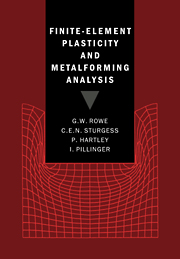Book contents
- Frontmatter
- Contents
- Preface
- Acknowledgements
- Nomenclature
- 1 General introduction to the finite-element method
- 2 Basic formulation for elastic deformation
- 3 Small-deformation elastic–plastic analysis
- 4 Finite-element plasticity on microcomputers
- 5 Finite-strain formulation for metalforming analysis
- 6 Implementation of the finite-strain formulation
- 7 Practical applications
- 8 Future developments
- Appendix 1 Derivation of small-strain [B] matrix for 2-D triangular element
- Appendix 2 Derivation of elastic [D] matrix
- Appendix 3 Derivation of elastic–plastic [D] matrix
- Appendix 4 Derivation of small-strain stiffness matrix [K] for plane-stress triangular element
- Appendix 5 Solution of stiffness equations by Gaussian elimination and back-substitution
- Appendix 6 Imposition of boundary conditions
- Appendix 7 Relationship between elastic moduli E, G and κ
- Appendix 8 Vectors and tensors
- Appendix 9 Stress in a deforming body
- Appendix 10 Stress rates
- Appendix 11 Listing of BASIC program for small-deformation elastic–plastic FE analysis
- Bibliography
- Index
1 - General introduction to the finite-element method
Published online by Cambridge University Press: 22 September 2009
- Frontmatter
- Contents
- Preface
- Acknowledgements
- Nomenclature
- 1 General introduction to the finite-element method
- 2 Basic formulation for elastic deformation
- 3 Small-deformation elastic–plastic analysis
- 4 Finite-element plasticity on microcomputers
- 5 Finite-strain formulation for metalforming analysis
- 6 Implementation of the finite-strain formulation
- 7 Practical applications
- 8 Future developments
- Appendix 1 Derivation of small-strain [B] matrix for 2-D triangular element
- Appendix 2 Derivation of elastic [D] matrix
- Appendix 3 Derivation of elastic–plastic [D] matrix
- Appendix 4 Derivation of small-strain stiffness matrix [K] for plane-stress triangular element
- Appendix 5 Solution of stiffness equations by Gaussian elimination and back-substitution
- Appendix 6 Imposition of boundary conditions
- Appendix 7 Relationship between elastic moduli E, G and κ
- Appendix 8 Vectors and tensors
- Appendix 9 Stress in a deforming body
- Appendix 10 Stress rates
- Appendix 11 Listing of BASIC program for small-deformation elastic–plastic FE analysis
- Bibliography
- Index
Summary
INTRODUCTION
Metalforming is an ancient art and was the subject of closely-guarded secrets in antiquity. In many respects the old craft traditions have been retained until the present time, even incorporating empirical rules and practices in automated production lines. Such techniques have been successful when applied with skill, and when finely adjusted for specific purposes. Unfortunately, serious problems arise in commissioning a new production line or when a change is made from one well-known material to another whose characteristics are less familiar. The current trend towards adaptive computer control and flexible manufacturing systems calls for more precise definition and understanding of the processes, while at the same time offering the possibility of much better control of product dimensions and quality. This is especially important in the advanced aerospace and other industries, where the advantages of new materials have to be fully exploited as quickly as possible.
Alloys that have been specifically designed to withstand high temperatures provide one example where the tools are stressed to their limits and the alloys themselves may be deformable only within narrow ranges of temperature and strain-rate. Practical tests to determine the best tool shapes and forming conditions can be very expensive and wasteful of scarce tool and workpiece material. A single turbine blade may cost several thousand pounds, so any reduction in prototype manufacturing costs is clearly valuable.
- Type
- Chapter
- Information
- Finite-Element Plasticity and Metalforming Analysis , pp. 1 - 13Publisher: Cambridge University PressPrint publication year: 1991
- 1
- Cited by



